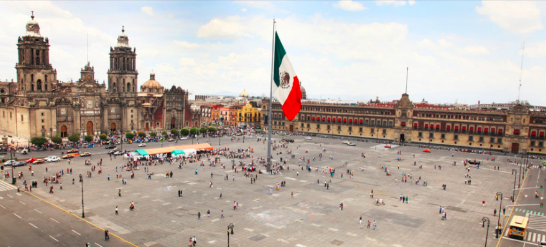Mexico: How Far Have its Institutions Really Come?
The question remains if Mexico has achieved a degree of institutional development consistent with its participation in those organizations.
A Daily Publication of The Dialogue
Foreign direct investment in Latin America hit a record high in 2022, with $225 billion committed from investors to Latin America and the Caribbean—55 percent more than 2021, according to the U.N. Economic Commission for Latin America and the Caribbean, or ECLAC, the Financial Times reported Aug. 30. Yet Mexico, which accounts for nearly a quarter of the region’s economic activity, secured only 17 percent of its total foreign investment last year. What accounts for the investment boom in the region, and why is Mexico lagging behind? What factors would make Mexico more attractive in the nearshoring trend? Will Mexico’s prospects change after the 2024 election?
Arturo Sarukhan, board member of the Inter-American Dialogue and former Mexican ambassador to the United States: “Mexico has been underperforming in terms of growth, inclusion and poverty reduction as compared to similar countries. Its economic growth averaged just above 2 percent a year between 1980 and 2022, limiting progress in convergence relative to high-income economies. But now it has also been walking backward into the political patterns under which it lived before 2000. As the United States recalibrates its ties with China and reshoring to North America rears its head, Mexico faces the proverbial gap between promise and reality. The promise: by virtue of geography, its four-decade-long trade and economic integration with the United States, the modernizing of the NAFTA—now USMCA—and the consolidation of the key paradigm prevalent among the three trading partners of integrated supply chains and joint production platforms, Mexico could be poised to singularly reap the benefits of a strategic sea-change and a once-in-a-generation opportunity. The reality: the country is unable to fully capitalize these trends because of López Obrador’s current policies. As nearshoring is increasingly being re-tweaked conceptually in Washington as ally-shoring or friend-shoring for essential supply chains, López Obrador, whether it’s on regional democracy and human rights, boycotting the Summit of the Americas, his posture on Russian aggression or his habit of poking his finger in Biden’s eye at every opportunity, is behaving as anything but a friend or ally of the United States. And while expanding insecurity and the growing shadow of organized crime might also play a role in current FDI flows, his energy and renewables policy paradigm, a key component for the success of nearshoring in North America and the transition to a digital economy, and his habit of extorting foreign companies operating in Mexico to do his bidding, are taking a toll. Regardless of who wins in 2024, a U-turn is urgently needed if Mexico City is serious about tapping into this potential.”
Lucinda Vargas, college professor of economics at New Mexico State University: “The dynamics of foreign direct investment in Mexico are best analyzed by looking at the performance of its maquiladora export manufacturing industry. This industry has two characteristics that are especially conducive to growth in the context of nearshoring: maquiladoras are largely located in Mexico’s northern border right next to the United States, and its top foreign direct investor is the United States, the world’s largest consumer market. Thus, in any nearshoring logic, the relocation of production from Asia to locations nearer to the United States, there are none nearer than Mexico from both a world and Latin American perspective, and none even nearer than locations on Mexico’s northern border. Indeed, in 2022, investment in the maquiladora industry reached a record high of $14 billion, chiefly the result of the nearshoring impetus. Three of the top five destinations of foreign direct investment in Mexico in 2022 were border states—Nuevo León, Tesla’s chosen site for a new megaplant; Baja California and Chihuahua. Thus, while in 2022 Mexico’s 17 percent share of foreign direct investment in Latin America was a distant second to Brazil’s 41 percent, Mexico managed to maintain an upward trend in foreign direct investment through the pandemic in 2020, when Brazil’s foreign direct investment contracted by more than 45 percent. Behind Mexico’s non-stop growth in foreign direct investment in the last three years is a combination of its entrenched maquiladora industry, its next-door proximity to the United States and nearshoring trends, all factors which are likely to keep this investment growing into and past the 2024 election.”
Diego Marroquín Bitar, senior research analyst in the global economy and development program at the Brookings Institute: “Companies and governments across the globe now prioritize transparency and resiliency over cost reduction and efficiency in their supply chains. As production shifts away from China and closer to their consumer base, Latin America stands to win. Among its peers, Mexico appears poised to make the largest gains, with a potential $35 billion in additional exports—equivalent to half of the region’s nearshoring dividends, according to IDB estimates. To date, Mexico is the United States’ top trading partner, with over $1.5 million exchanged per minute (up 27 percent from 2019 levels), has solid macro fundamentals and unparalleled access to the U.S. and Canadian markets through the United States-Mexico-Canada Agreement (USMCA). However, geography and trade agreements alone fall short of fully harnessing the region’s FDI boom. Significant setbacks in clean energy generation (5 percent less compared to 2018 levels), high levels of hydric stress (over 45 percent across the country), violence (nine Mexican cities are among the top 10 with the most homicides worldwide) and rule of law issues (with several energy companies unable to operate due to permitting issues) discourage further investment in the country. Similarly, deficient infrastructure (Mexico ranks 66 out of 139 in the World Bank’s Logistics Performance Index) inflates costs relative to other nearshoring options (for example, Vietnam) and hampers market accessibility. Mexico’s first female president, whether Claudia or Xóchitl, must confront these challenges head-on if they wish to transform Mexico’s current FDI stream into an FDI tsunami. Without immediate action on energy, security, infrastructure, rule of law and water management, Mexico will once again become the land of (missed) opportunities and fall short of its true potential.”
Arnulfo Rodríguez, principal economist at BBVA research: “Foreign direct investment (FDI) flows into Mexico in 2022 explained by nearshoring appear to be just supported by anecdotal evidence. FDI data and the negligible market share gain of Mexico in the United States imports of manufactured goods since 2018 do not seem to back up the nearshoring story. For example, after excluding the one-off investments of the Televisa-Univision merger and Aeromexico’s restructuring in the first half of 2022, annual FDI flows into Mexico are still below pre-pandemic levels. Moreover, most of these flows in 2022 were profit reinvestments (56 percent) while new investments accounted for only 36 percent. Regarding the share of Mexico in the aforementioned market, the country could not take advantage of the 5.5 percentage points lost by China in the aftermath of the pandemic and trade war with the United States. Indeed, Mexico just gained 0.4 percentage points between 2018 and 2022 while Vietnam and Taiwan won 2.3 and 1.2 percentage points, respectively. To be more attractive for nearshoring opportunities and reap more economic benefits in the medium term, Mexico needs a strong rule of law along with industrial, energy and fiscal policies that promote a new wave of investments associated with electric vehicles, renewable energy and IT equipment.”
 The Latin America Advisor features Q&A from leaders in politics, economics, and finance every business day. It is available to members of the Dialogue’s Corporate Program and others by subscription.
The Latin America Advisor features Q&A from leaders in politics, economics, and finance every business day. It is available to members of the Dialogue’s Corporate Program and others by subscription.
The question remains if Mexico has achieved a degree of institutional development consistent with its participation in those organizations.
Focusing on transnational crime is a top priority of the Obama administration’s policy in Latin America.
What is the outlook for Ecopetrol and the Colombian oil sector in the short to medium term?
 Foreign direct investment in Latin America reached $225 billion in 2022, a record high. However, Mexico attracted only 17 percent of that total. Mexico City is pictured. // File Photo: Mexican Government.
Foreign direct investment in Latin America reached $225 billion in 2022, a record high. However, Mexico attracted only 17 percent of that total. Mexico City is pictured. // File Photo: Mexican Government.